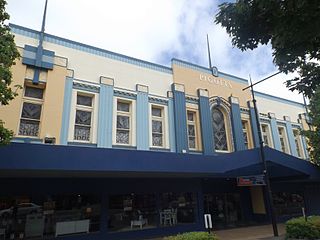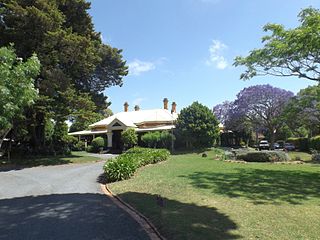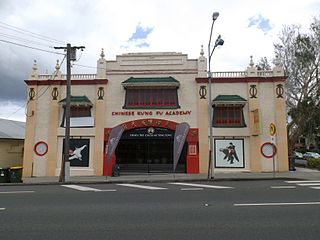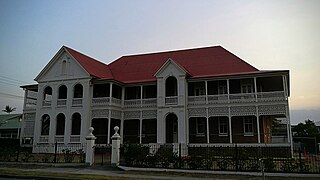
The Empire Theatre is a heritage-listed theatre at 56 & 56A Neil Street, Toowoomba, Toowoomba Region, Queensland, Australia. It was added to the Queensland Heritage Register on May 31, 1994.

Regent Theatre was a heritage-listed cinema at 167 Queen Street, Brisbane City, City of Brisbane, Queensland, Australia. It was designed by Richard Gailey, Junior, Charles N Hollinshed, and Aaron Bolot and built from 1928 to 1929 by J & E L Rees and A J Dickenson. It was one of the original Hoyts' Picture Palaces from the 1920s. It is also known as Regent Building. The auditorium interior was largely lost when it was converted into a 4 screen complex in 1979-80, but the building, including the surviving entrance and main foyer, was added to the Queensland Heritage Register on 21 October 1992.

The Orient Hotel is a heritage-listed hotel at 560 Queen Street, Brisbane CBD, City of Brisbane, Queensland, Australia, on the corner of Ann Street. It was originally built as the Excelsior Hotel in 1875 and extended in 1884, both of which were designed by Brisbane architect Richard Gailey. It was added to the Queensland Heritage Register on 23 April 1999.

Bishop's House is a heritage-listed villa at 73 Margaret Street, East Toowoomba, Toowoomba, Toowoomba Region, Queensland, Australia. It was designed by Henry Marks and built from 1910 to c. 1911 and from 1939 to c. 1940. It is also known as Dalmally and Kilallah. It was added to the Queensland Heritage Register on 21 October 1992.

Pigott's Building is a heritage-listed commercial building and former department store at 381-391 Ruthven Street, Toowoomba, Queensland, Australia. It was designed by Toowoomba firm James Marks and Son, and built in 1910 as the principal store of the Pigott & Co. department store chain, replacing an earlier 1902 store on the site that had burned down in 1909. The store was extended in 1914, 1935, 1956, and again in the 1960s.

Soldiers Memorial Hall is a heritage-listed memorial at 149 Herries Street, Toowoomba City, Queensland, Australia. It was designed by Hodgen & Hodgen (Toowoomba) and built from 1923 to 1959 by Smith Bros (Toowoomba). It was added to the Queensland Heritage Register on 17 December 1999.

Vacy Hall is a heritage-listed villa at 135 Russell Street, Toowoomba, Toowoomba Region, Queensland, Australia. It was built c. 1899. It was added to the Queensland Heritage Register on 21 October 1992.

Chateau Nous is a heritage-listed villa at 1 Rupert Terrace, Ascot, Queensland, Australia. It was designed by Douglas Francis Woodcraft Roberts and built from c. 1937 to 1940s. It was added to the Queensland Heritage Register on 21 October 1992.

Plaza Theatre is a heritage-listed cinema at 163–169 Latrobe Terrace, Paddington, Queensland, Australia. It was designed by Richard Gailey, Junior and built from 1929 to c. 1929 by John Hutchinson. It is now known as Empire Revival. It was added to the Queensland Heritage Register on 28 March 2003.

Triumph Cinema is a heritage-listed former cinema at 963 Stanley Street, East Brisbane, City of Brisbane, Queensland, Australia. It was designed by Arthur Robson and built in 1927. It is also known as East Brisbane Picture Theatre, Elite Cinema, and Classic Cinema. It was added to the Queensland Heritage Register on 27 July 2001.

Mount Carmel Convent is a heritage-listed former Roman Catholic convent at 199 Bay Terrace, Wynnum, City of Brisbane, Queensland, Australia. It was designed by Hall & Dods and built in 1915 by William Richard Juster. It was added to the Queensland Heritage Register on 27 August 1999.

Empire Hotel is a heritage-listed hotel at 339 Brunswick Street, Fortitude Valley, City of Brisbane, Queensland, Australia. It was designed by Richard Gailey and built in 1888 by Smith and Ball. It was renovated in 1925 to a design by Richard Gailey, Junior. It was further renovated in 1937 to incorporate apartments designed by Hall and Phillips. It was added to the Queensland Heritage Register on 21 October 1992.

Normanby Hotel is a heritage-listed hotel at 1 Musgrave Road, Red Hill, City of Brisbane, Queensland, Australia. It was designed by John B Nicholson and built in by Thomas Game. It was extended in 1917 to a design by George Henry Male Addison. It was added to the Queensland Heritage Register on 21 October 1992.

La Scala is a heritage-listed detached house at 517 Brunswick Street, Fortitude Valley, City of Brisbane, Queensland, Australia. It was designed by Thomas Ramsay Hall and built c. 1915. It was originally known as Craig Athol. It was added to the Queensland Heritage Register on 21 October 1992.

National Hotel is a heritage-listed hotel at 35 Grafton Street, Warwick, Southern Downs Region, Queensland, Australia. It was designed by James Marks and Son built in 1907 by Daniel Connolly. It is also known as Allman's Hotel. It was added to the Queensland Heritage Register on 21 October 1992.

Queen's Hotel is a heritage-listed former hotel at 12 The Strand, Townsville CBD, City of Townsville, Queensland, Australia. It was built from 1902 to 1920s. It is also known as the Telecasters North Queensland Ltd Building. It was added to the Queensland Heritage Register on 21 October 1992.

Great Northern Hotel is a heritage-listed hotel at 500 Flinders Street, Townsville CBD, City of Townsville, Queensland, Australia. It was designed by Tunbridge & Tunbridge and built from 1900 to 1901. It was added to the Queensland Heritage Register on 21 October 1992.

Hibernian Hall is a heritage-listed community hall at 38-44 Hawthorne Street, Roma, Maranoa Region, Queensland, Australia. It was designed by Cavanagh & Cavanagh and built from 1931 to 1932 by George Power Williams. It is also known as HACBS Hall. It was added to the Queensland Heritage Register on 27 April 2001.

Astor Theatre is a heritage-listed cinema at 77 Burrowes Street, Surat, Maranoa Region, Queensland, Australia. It was built from 1925 to 1960s. It was added to the Queensland Heritage Register on 27 September 2002.

Hotel Corones is a heritage-listed hotel at 33 Wills Street, Charleville, Shire of Murweh, Queensland, Australia. It was designed by William Hodgen junior and built from 1924 to 1929 by day labour. It is also known as Corones Hotel Norman. It was added to the Queensland Heritage Register on 1 July 1997.























